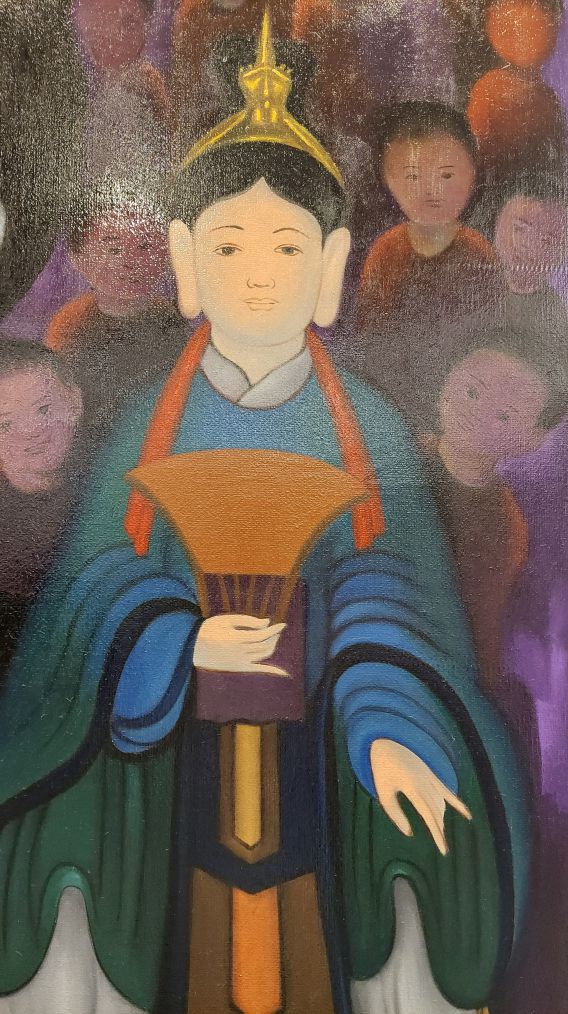36 paintings with the main material being oil painting and lacquer, exhibited as a strip of time in which the portraits are an existing part of it, with full symbolism and contrast, evoking many reminders from viewers.
With 24 oil paintings and 12 lacquer paintings, medium and large, composed from 2018 - 2025, " portrait of Time" is both an emotion, an exploration and a reflection of the author in the process of expressing his personal voice. Not paying attention to the genre of landscape or still life paintings like other artists, Pham Duy Quynh exploits portrait paintings to find differences.
In the portrait area, the artist does not paint images of young women that are usually sexy, but focuses on the two main groups: the elderly - children, the elderly - the common people, thereby expressing their liveliness.
"Reducing" the color, "reducing" the space - something that landscape paintings and still lifes can easily bring to go deep into the portrait painting space is a difficulty for me. Moreover, when painting a portrait, creating a beautiful and strange layout for a painting is also a big challenge. Pham Duy Quynh put himself in a working position in a locality with " little acting land", needing more reflection than temporary emotions.
The most emotional paintings in the exhibition are the oil paintings that the artist painted with his grandmother. A farmer in Thai Binh passed away at the age of 101 last year. The time she lived with her youngest son's family (the artist's father) in the last years gave him memories and a deep impression of a class of people whose presence gradually declined too much.
The grandmother was unliterate, but like many old women born before 1945, she wrote many poems, told Kieu's stories, told every story as if telling her own life, full of truth and appeal.
Her grandmother told me that "in the time of the war of chaos and hunger in 1945, every time I went out on the street, I met so many people who died, children who had lost both parents and each of them", perhaps that is not a coincidence that many children appear in Quynh's paintings.

Some children's paintings are the main characters, but more are those in which they are supporting characters, the majority, the crowd, the front, the back, and around the main characters. Most of them appeared with hardship, self-consciousness, and unfavorable fates from the child.
Pham Duy Quynh depicts the children in the same painting as the portrait of the king and queen of the Nguyen Dynasty - with the contrast of generations, classes, and positions in society, the contrast of time (the golden caps of the past with the innocent faces of today), between the famous people of the past and the unknown. The repetition of portraits of kings and kings with caps makes viewers ask, what does that appearance mean in terms of appearance and concept?
The artist must not have been unintentional in giving these visual signs. But if we associate the contrast with the judgment of contemporaries, to only look at the dark side of history or the times, then perhaps it is something Pham Duy Quynh does not think of. What he wants to aim for is perhaps the eternity of time: No king or queen shall live forever in the world, just like there was never a time when everywhere there were no children who had to work hard to make a living.
Quynh's charm, which is in many of the children he paints, always has a clear, thienle look; the innocentness of a child makes viewers think less and think less and become moved. The line between position, status, or the just - commoner is no longer the only way for visual connections. The townspeople and courtesans who come out of folk culture are another way to protect and shelter the world of human fate and will become adults and will become adults.
Many colleagues have a good impression of Pham Duy Quynh's lacquer painting, believing that this is a path that he can take a deep step in in making his personal painting impression. Some of Quynh's lacquer paintings in this exhibition have also tended to gradually limit details, no longer clearly showing the portraits of specific kings or queens, as well as not really depicting the official hats, but as an aesthetic signal, more suggestive than the name, more symbolic than the name.
Exploiting historical, traditional and folk elements to include in painting works is a way that many artists today find a way for themselves. Aesthetics and symbols have the ability to clarify and deepen the author's ideas, especially when they are naturally and smoothly combined. However, if harmony is not achieved, the painting will easily become forced, awkward, lost in constructions and difficult to convince the viewer.
Going deeper into the world of those who choose painting as their career, they will see a really difficult path. How to not spread time to focus on painting, how to have a unique style of creating images differently from everyone, how to make each stage of your creative process a new, unique mark - are questions that not everyone can confidently answer to themselves.
Talent always comes with hard work, in the long run, one cannot rely on temporary excitement and explosive emotions. Beauty in the soul must be a "word" that is built up, spread, and come to everyone. But how? When Quynh entered Portrait of Time to paint, perhaps he himself began to answer general questions in his own persistent way.











